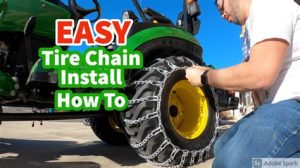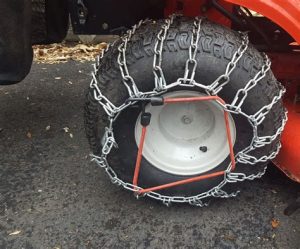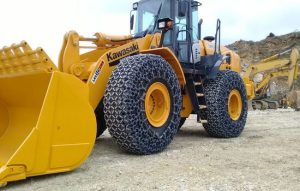Explore types of chains, learn sizing, installation techniques, maintenance tips, and safety regulations for optimal performance and longevity in your projects.When it comes to tackling tough terrain with your tractor, installing tire chains can make all the difference in ensuring safety and efficiency. While the thought of adding chains may seem straightforward, there’s more to it than meets the eye. In this blog post, we’ll delve into expert insights on selecting the right chains for your tractor, guiding you through the various types available and how to choose the perfect size and fit. We’ll also cover essential installation techniques to help you get the job done right, along with maintenance tips to extend the life of your chains. Finally, we’ll highlight important safety precautions and regulations to keep you compliant while you work. Whether you’re a seasoned farmer or new to tractor operations, this comprehensive guide will equip you with the knowledge you need for optimal performance and safety.
Understanding the Different Types of Chains
When it comes to enhancing traction on your tractor tires, selecting the right *chain type* is crucial. There are several *types of tire chains* that serve different purposes depending on the conditions and usage. Here, we will explore the most common types to help you make an informed decision.
| Type of Chain | Best For | Features |
|---|---|---|
| Link Chains | General farming and transport | Durable and versatile; great for hauling and general use. |
| Ladder Chains | Snow and ice | Designed for maximum grip; ideal for icy conditions. |
| Diamond Chains | Off-road and rugged terrain | Provides excellent traction on uneven surfaces; reduces wear on tires. |
| V-Bar Chains | Extreme conditions | Heavy-duty with sharp V-bars; excellent for deep snow and mud. |
Each type of *chain* offers unique advantages, making it essential to assess your specific needs. If you’re primarily operating in winter conditions, for instance, *ladder chains* may provide the grip you require, while *diamond chains* can be effective for agricultural work in varying terrains.
Additionally, consider the *material* of the chains. Most chains are made from hardened steel, which offers exceptional durability and resistance to wear. The choice of chain should also depend on the tread pattern of your tractor tires, ensuring a proper fit and optimal performance.
In summary, understanding the different types of *chains* available can greatly enhance your tractor’s performance. By choosing the right type based on your specific environment and requirements, you can ensure better traction, improved safety, and reduced wear on your tires.
Selecting the Right Size and Fit
When it comes to installing chains on your tractor tires, selecting the right size and fit is crucial for optimal performance and safety. Chains that are too loose can come off during operation, while those that are too tight can damage your tires. It’s important to refer to the manufacturer’s guidelines for specific sizing recommendations.
- Tire Size: Check the sidewall of your tire for its dimensions.
- Chain Type: Different types of chains are available, such as ladder chains or diamond chains. Choose one that matches your requirements.
- Clearance: Ensure that there is enough space between the tire and other components of the tractor, especially when the tire is under load.
One effective method for determining the correct chain size is to measure your tire’s width and diameter. This measurement can be cross-referenced with a manufacturer’s chain size chart to find the compatible chain size. For example, if your tire measures 12.4 x 24, you might need a chain size that corresponds to those dimensions.
Proper Installation Techniques
Installing chains on your tractor tires is crucial for enhancing traction and stability, especially in challenging conditions. Proper installation ensures that the chains function effectively and prolongs their lifespan. Here are some expert techniques to consider for a successful installation.
1. Choosing the Right Location: Always perform the installation in a clean and dry area. Ensure that the ground is stable to provide a safe working environment. Additionally, it’s advisable to position the tractor on flat terrain to avoid complications during the installation process.
2. Preparation of the Chains: Before installation, inspect your chains for any damage or wear. Lay them out flat on the ground, removing any kinks or tangles. This will make it easier to fit them around the tires and avoid any unnecessary strain once they are installed.
3. Installation Process: Begin by draping the chains over the tire, starting from the top. Make sure that the chains are evenly distributed. Push the lower section of the chain down towards the ground and pull the ends together to secure them. Always refer to the manufacturer’s instructions regarding the correct tensioning method, as improper tension can lead to chain failure or tire damage.
| Step | Description |
|---|---|
| 1 | Inspect the chains for wear and tear. |
| 2 | Lay the chains flat to remove any tangles. |
| 3 | Drape the chains over the tire from the top down. |
| 4 | Secure the ends, ensuring proper tension. |
Following these installation techniques will help ensure that your tractor’s chains perform optimally. Regular checks and adjustments are also recommended to maintain the proper fit during use.
Maintenance and Care Tips
Proper maintenance and care of your tractor chains is crucial for ensuring their longevity and optimal performance. Regular attention can help prevent wear and tear, as well as extend the life of the chains.
- Regular Inspection: Routinely check the chains for any signs of damage, such as broken links or worn surfaces.
- Clean After Use: After each use, clean the chains to remove dirt and debris that can cause rust and corrosion.
- Lubrication: Apply a suitable lubricant to the chains to avoid friction and reduce wear.
Lastly, always store your chains in a dry, secure location when not in use. This will help prevent any exposure to moisture or harsh conditions that can lead to rusting or deterioration.
By adhering to these maintenance and care tips, you can ensure that your tractor chains remain in excellent condition throughout their usage. Remember, a little effort in maintaining your equipment goes a long way in enhancing its overall performance.
Safety Precautions and Regulations
When it comes to installing chains on your tractor tires, adhering to safety precautions and regulations is crucial. This not only ensures your protection but also extends the lifespan of the equipment.
- Personal Protective Equipment (PPE): Always wear proper gear, including gloves, safety goggles, and steel-toed boots to minimize the risk of injury.
- Understand Weight Limits: Before installing chains, check the manufacturer’s guidelines regarding the weight capacity of both the chains and the tractor.
- Inspect the Surroundings: Ensure the installation area is clear of obstacles and hazards to prevent accidents.
- Follow Installation Guidelines: Adhere to the specific installation instructions provided by the manufacturer, ensuring that the chains are properly fitted.
- Use Appropriate Tools: Make sure to have the right tools on hand, such as wrenches and pliers, to help with the installation process and avoid makeshift solutions.
Additionally, familiarize yourself with local regulations regarding the use of chains on tractor tires. Some regions may have specific rules that govern the use of tire chains, especially on public roads or during certain weather conditions. Ignoring these regulations can lead to fines or penalties.
Another important aspect is to regularly check your chains for wear and tear. If any signs of damage are apparent, replace them immediately to maintain safety. Proper maintenance not only keeps your tractor operating efficiently but also enhances your safety while using the equipment.
Frequently Asked Questions
Why is it important to install chains on tractor tires?
Chains provide improved traction on slippery or icy surfaces, reduce wheel slippage, and enhance the overall stability of the tractor in challenging conditions.
What type of chains should I use for my tractor tires?
The type of chains you choose will depend on the tire size and the intended use. Options include link type chains, ladder style chains, and diamond style chains, with varying degrees of traction and durability.
How do I determine the correct size of chains for my tractor tires?
To determine the correct size, check the tire size printed on the sidewall and refer to the manufacturer’s specifications for the appropriate chain size that fits your tires.
What are the steps for installing chains on tractor tires?
Begin by parking the tractor on a flat surface, then lay the chains out flat and drape them over the top of the tire. Connect the hooks and ensure the chains are evenly distributed before tightening any tensioners.
Can I install chains on my tractor tires by myself?
Yes, you can install chains on your tractor tires yourself, but it’s recommended to have a helper for efficiency and safety while handling heavy chains.
How do I maintain my tire chains once they are installed?
Inspect the chains regularly for wear and tear, ensure they are properly tensioned, and clean them after use to prevent rust and prolong their lifespan.
Are there any safety precautions to consider when using tire chains?
Yes, ensure that the chains are securely fastened and check for any loose links or damage before use. Avoid excess speeds when driving with chains, and be cautious of turning and braking as chains can affect vehicle handling.





